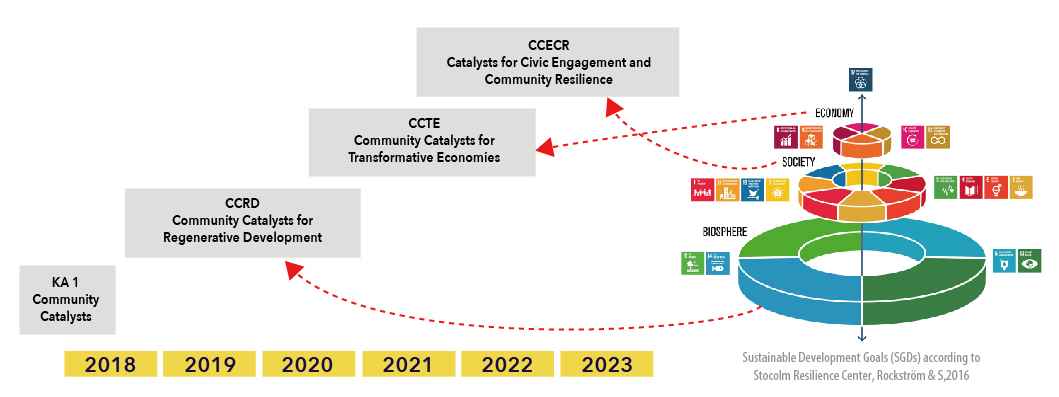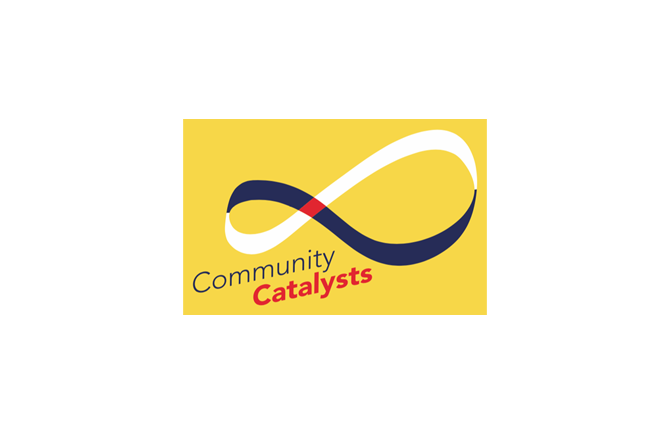Our aspiration is to contribute to a paradigm shift in local community and (bio)regional development (see next section). More specifically, we seek to collect, test, improve and share practices that root co-creative action for system transformation in the unique place-based potential of landscape, settlements, culture, people and other living beings. Our focus is on the roles and practices of Community Catalysts spearheading this new paradigm. We intend to stimulate the creation of local and trans-local Communities of Practice of Community Catalysts. Ultimately, we have the ambition to co-shape what it means to be(come) a Community Catalyst. Through our multi-partner projects we develop learning materials and pathways as well as complementary tools and support for generating livelihoods as Community Catalysts.
The 17 Sustainable Development Goals (SDGs) of the United Nations for 2030 and the regular progress tracking of their 169 targets represent the currently dominant international ‘’language’’ for having conversations on desirable futures and for coordinating respective action across scales, from local to national to international. The SDGs provide a multidimensional framing that acknowledges the interconnectedness of the different goals.
As Community Catalyst Partnership, we recognize the benefits of such a shared language for engaging highly diverse contributors with each other around a shared agenda..As systemic thinkers and actors, we also value the attempt to establish an interconnected multidimensional framework.
At the same time, we remain critical regarding the flat, side-by-side view of economic, social and environmental goals, in particular regarding the unavowed tensions within Goal 8 (“inclusive and sustainable economic growth”) and between this goal and the range of other environmental and social goals. Looking at our societal metabolism from a purely physical perspective, we rather share the view that economic growth continuously pursued without restraint at global scale on a finite planet necessarily ends up undermining all other goals of human development and environmental protection as it leads to overstretching the planetary boundaries.
According to a recent meta-study, there is no evidence whatsoever for any absolute decoupling of economic growth from natural resource use internationally. Decoupling, however, sits at the core of the “green growth” narrative of the UN, the OECD, the EU and most national governments worldwide, with the notable exceptions of Bhutan’s Gross National Happiness, Ecuadors’ and Bolivia’s Buen Vivir and New Zealand’s Wellbeing frameworks. Otherwise, the green growth narrative pervades the SDGs as much as most local, regional and national socioeconomic and spatial development policies and practices. This narrative is unwarranted, though. It has no basis in physical reality and therefore needs to be overcome as much as the institutions and practices derived from it.
In order to take advantage of the above mentioned benefits of the SDG language without being subjected to the misrepresentations and blind spots of this framing, we turned our attention to the reinterpretation of the SDGs suggested in 2016 by the Stockholm Resilience Centre. It is called the “wedding cake” representation of the SDGs as it repositions the economy as part of society and society as part of the biosphere. It hence establishes a proper layered relation between the economic, social and ecosystem-related goals.
Our strategy was to design a dedicated project per layer of the “wedding cake” (see next section) and to relate these projects to each other within this overall framing. This allows us to stay connected with the broad conversations and implementation dynamics spurred by the SDGs at all scales and in all sectors of society, while pioneering the new paradigm beyond and after a “sustainable development” that, in fact, didn’t manage to deviate our civilization from its unsustainable and ultimately self-destructive path.
As a summary indicator for many deeply concerning trends, the Earth Overshoot Day hits ever earlier, except in the very few years of major international economic downturns, such as the 2009 financial crisis and the 2020 standstill during the recent pandemic. We find this revealing. Likewise, climate change is intensifying according to the latest reports of the Intergovernmental Panel on Climate Change and the aspirational 1.5 degrees goal of the Paris agreement seems already now out of reach..
This overall direction of increasing rather than decreasing overshoot and climate change went basically unfettered in the generational span of 30 years since the UN Earth Summit 1992 in Rio that triggered ongoing international cooperation on sustainable development. Hence the need to go beyond the state of the art of actually unsustainable “sustainable development”. This requires imagining and enacting a new paradigm. Happily this new paradigm foregrounding Regenerative Development, Civic Engagement, Community Resilience and Transformative Economies is about to emerge (see next section).
The Community Catalyst project series covers the layers of the wedding cake representation of the UN Sustainable Development Goals (see previous section) as follows:

An initial training (Erasmus+ KA1, Youth, 2018) designed to let the Community Catalyst vision emerge.
The project CCRD: Community Catalysts for Regenerative Development (Erasmus+ KA2, Youth 2018-2020) has its focus on the biosphere layer.
The project CCECR: Community Catalysts for Civic Engagement and Community Resilience (Erasmus+ KA2, Adult Education 2022-2024) has its focus on the society layer.
The project CCTE: Community Catalysts for Transformative Economies (Erasmus+ KA2, Adult Education, 2020-2022) has its focus on the economy layer.
However, these foci are connected and often flow into each other in the holistic practices that we promote. For instance, economic activities always involve the collaboration of people and they always operate within and change ecosystems.
Each Community Catalyst project is based on an initial phase of participatory action research (PAR) in local communities in four different countries, cultures and languages (Sicily, Algarve, Catalunya, Hungary). Those place-sourced results inform the development of the tools and practices alongside more conceptual input from our research and trans-local network partners.
Our main resource is the enthusiasm, creativity, love and friendship of the contributors that came together through the Community Catalyst partnership. Next to these key ingredients, our co-creative work is fuelled by the productive mix of experiences and insights sourced from diverse locations and cultures, as well as from facilitating community groups, participatory action research and activism for a new paradigm of local and (bio)regional development.
Each of the projects has been financially supported by the Erasmus+ programme as a strategic or cooperation partnership. Erasmus+ is the EU programme for innovation and capacity building in education, training and youth through transnational cooperation and mobility..
We are also exploring approaches for resourcing the further evolution of the Community Catalyst field of practice beyond grant-funded projects that are limited in time and scope.
The outputs of the projects including guidelines, tools and learning materials are made available free of charge under the creative commons licence specified in the footer of this portal. You can download or access those materials through the links in the last section of the page of each individual project. Even though we make them already available, please be aware that most materials continue going through iterations of testing, reflection and improvement. Your feedback is most welcome and supports this process. You are also invited to share transformative practices from your place, culture or domain of activity to broaden the repository of practices available on the platform.

